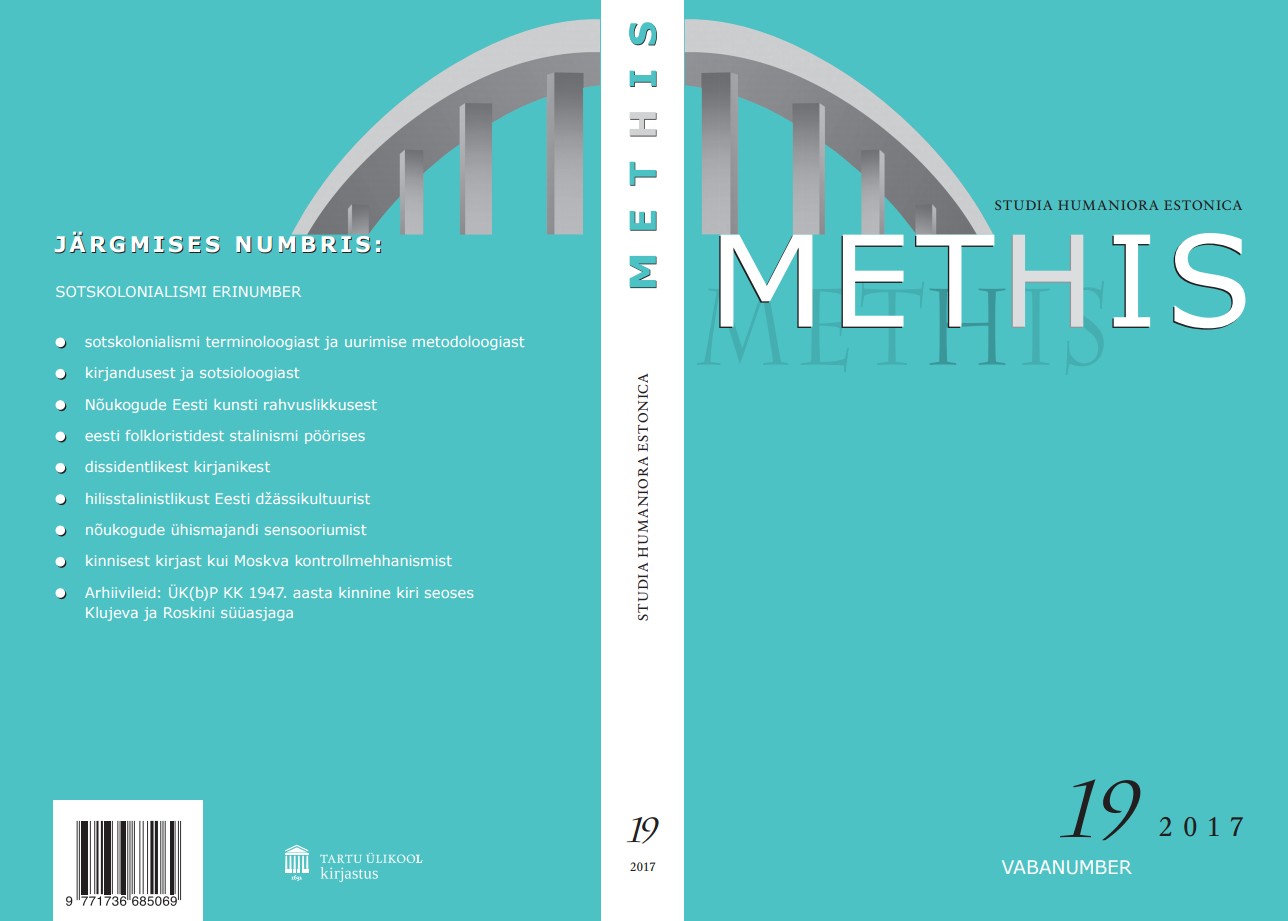Teatrietenduste sünkroontõlkest eesti keelest vene keelde aastatel 1944–1991 / Simultaneous interpreting of theatre performances from Estonian into Russian from 1944 to 1991
DOI:
https://doi.org/10.7592/methis.v15i19.13436Keywords:
taidetõlge, suuline tõlge, subtiitrid, sünkroontõlge, literary translation, oral translation, subtitles, simultaneous interpretingAbstract
Suuline teatritõlge on jäänud marginaalse tõlkeliigina uurijate tähelepanu alt välja nii Eestis kui ka mujal. aastatel 1944–1991 on Eestis regulaarselt tõlgitud teatrietendusi eesti keelest vene keelde Tallinna Riiklikus Akadeemilises Draamateatris (Eesti Draamateatris), teater Vanemuises ja Lydia Koidula nimelises Pärnu Draamateatris (Endla Teatris). Kahes teatris on olnud tööl koosseisulised tõlgid, Pärnus vabakutseline tõlk. Artiklis analüüsitakse intervjuusid tõlkidega ning üldistatakse suuliseks esitamiseks tõlgitud kirjaliku teksti ettekandmise eripärasusi. Osutatakse, et teatritõlge ei ole valmis teksti ette- ega pealelugemine, vaid lõplik tõlge sünnib reaalajas, etenduse jooksul.
In Estonia the simultaneous interpretation of performances from Estonian into Russian has a long tradition dating back more than half a century; it has not, however, drawn the attention of researchers, theatre critics and reviewers. International academic research mostly focuses on the sign language interpretation of theatre performances for the deaf community. The author’s approach to theatre interpreting is therefore based on this, except that the interpreter is making the performance accessible not to the hearing-impaired but to audience members who do not master the original language of the performance. In the context of this article, therefore, “theatre interpreter” refers to a simultaneous interpreter who interprets theatre performances. There are certain similarities between the preparatory work of simultaneous and sign language theatre interpreters (and, for that matter, with that of audio describers): they work with the written text and the spoken word as well as on their comprehension and awareness of stage improvisation by the actors, combining both preparation and spontaneity.
When researching interpreting in Estonia from 1944 to 1991, the author established that this subtype of institutional interpretation took place in at least seven theatres. Performances were regularly interpreted from Estonian into Russian at three theatres: the Tallinn Drama Theatre, the Theatre Vanemuine in Tartu and the Pärnu Drama Theatre. At the Russian Drama Theatre, a few performances were also interpreted from Russian into Estonian. The theatres in Tallinn and Tartu employed staff interpreters, while the interpreter in Pärnu was a freelancer. In addition to these three interpreters another three also interpreted theatre performances once or twice. Archival research yielded factual evidence about the introduction of theatre interpreting in Estonia; this started in Tartu and Tallinn in 1952, and in Pärnu in 1967, where it was used during the summer season. Valeria Barsova, the staff interpreter at Vanemuine until 1995, was also temporarily tasked with interpreting operas in 1953; once she also interpreted a ballet at an open-air performance reading out the synopsis. Barsova had “a great voice for the microphone, a soft low alto, neither disturbingly sharp nor interfering, transmitting the meaning of the words expressed by the actors on the stage very clearly but almost as if unconsciously” (Süvalep 1978). Maia Soorm, a staff interpreter at the Estonian Drama Theatre in Tallinn for thirty-seven years, was awarded the Aleksander Kurtna Prize for her long-term dedication to theatre interpreting in 2010. Similar to her colleagues in Tartu and Tallinn, the interpreter who worked at the Pärnu theatre—Malle Šalda—got the job by chance. Neither she nor any of the other interpreters had any formal interpreter training. In addition to these three main interpreters, the author’s meticulous work in the archives led her to identify another three interpreters from the 1950s and 1960s: Helene Malin, Aleksandr Aisenstadt and Armilda Berzina.
Estonia’s three long-term theatre interpreters, all of whom are highly competent in their field, mastered not only fluency in the source and target languages but also the metamorphosis from a dramatic text into a stage interpretation. A major contributing factor to this was their long-term relationship with the theatre they worked at and the opportunity they had to participate in the production process. Theatre interpreting is a hybrid form in which both interpretation and translation must be considered (Turner, Pollitt 2002: 41). Yvonne Griesel (2009: 125) recommends treating translators and interpreters as partners and language experts for the stage.
In 1983, opera surtitles were introduced in the Canadian Opera Company. Since then, the use of surtitles has become widespread in opera houses all over the world. In operas, there is less improvisation than in drama productions. A lag between surtitles and the spoken word could have a detrimental effect on the entire production. Technical problems with surtitles can also disturb the audience members who do not understand the original. Despite such potential issues, over the last ten years surtitles have also begun to be used in many drama theatres. This is a particular way to solve linguistic issues at drama festivals. Static surtitles, however, do not take into account improvisation or contribute to the real-life theatre experience. The final version of theatre interpreting, on the other hand, is “performed live in real time” (Napier 2011: 373). Indeed, a good theatre interpreter may make the audience forget their headsets and the linguistic barrier.


